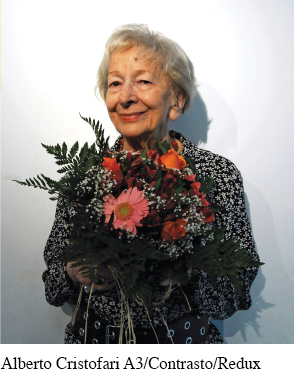7.10
A Contribution to Statistics
Wisława Szymborska

Translated by Stanisław Barańnczak and Claire Cavanagh
Wisława Szymborska [vis-
Out of a hundred people
those who always know better
— fifty-
doubting every step
5 — nearly all the rest,
glad to lend a hand
if it doesn’t take too long
— as high as forty-
always good
10 because they can’t be otherwise
— four, well maybe five,
able to admire without envy
— eighteen,
suffering illusions
15 induced by fleeting youth
— sixty, give or take a few,
not to be taken lightly
— forty and four,
living in constant fear
20 of someone or something
— seventy-
capable of happiness
— twenty-
harmless singly,
25 savage in crowds
— half at least,
cruel
when forced by circumstances
— better not to know
30 even ballpark figures,
wise after the fact
— just a couple more
than wise before it,
taking only things from life
35 — thirty
(I wish I were wrong),
hunched in pain,
no flashlight in the dark
— eighty-
40 sooner or later,
righteous
— thirty-
righteous
and understanding
45 — three,
worthy of compassion
— ninety-
mortal
— a hundred out of a hundred.
50 Thus far this figure still remains unchanged.
Understanding and Interpreting
Which human behaviors receive the highest percentages in the poem? Which ones receive the lowest? Overall, what does the speaker wish to communicate about how people behave from these percentages?
What are the aspects of humanity that the speaker chooses to focus on? How do these choices support the theme about people’s behavior to one other?
The way that people act, according to the speaker, is situational. Explain how the context of the situation affects people’s behavior as presented in this poem.
Analyzing Language, Style, and Structure
Notice how often Szymborska uses modifiers or qualifiers with the numbers. For instance, she writes “twenty-
something tops” (l. 23) instead of just “twenty.” What is the effect of these modifiers? The author does not present the topics she chooses in random order, and often groups the statistics in pairs or clusters of ideas. Choose one or more groups of statistics and explain how they connect to or reply to each other.
Some of the numbers the speaker provides are very specific, but others are vague. Why do you think she does so?
Reread the final stanza of the poem, beginning with “mortal.” How does this stanza serve as a conclusion for the rest of the poem?
Overall, is the tone pessimistic or optimistic? What language choices create this tone?
Connecting, Arguing, and Extending
Polish jazz trumpet player Tomasz Stanko, with his New York Quartet, recorded an album dedicated to Szymborska. Songs from the album, which is called Wisława, are available on YouTube and iTunes. Listen to one or more of the songs and explain how the music compares to the tone of “A Contribution to Statistics” or other Szymborska poems you have read.
Rewrite the numbers for the lines with which you disagree, and write an argument in which you explain why you made the numbers higher or lower than Szymborska did.
Write a new poem called “A Contribution to Statistics in High School” that focuses on the teachers, students, administrators, community members, and parents involved in your school. Analyze the tone of your own poem. How similar to or different from the original is the tone of your poem?